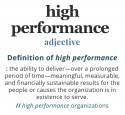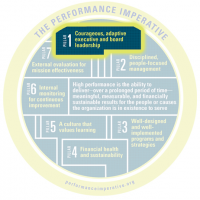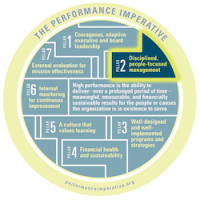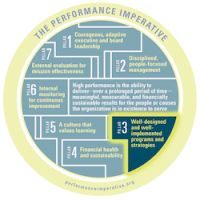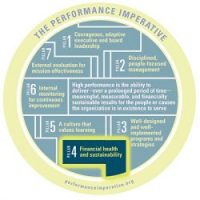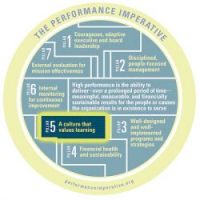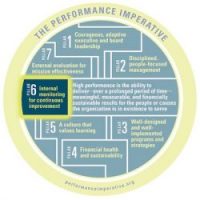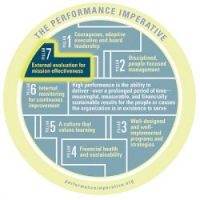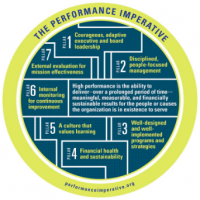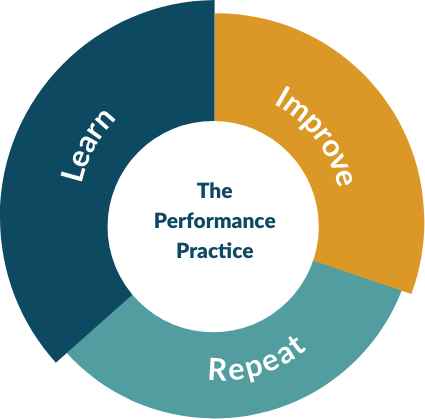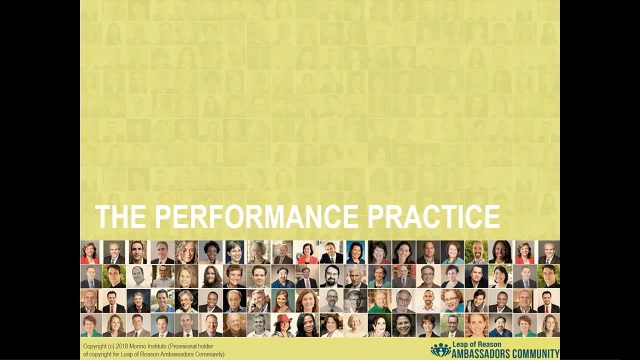Principle 1.1: Executives and boards embrace their responsibility to deliver meaningful, measurable, and financially sustainable results.
1.1.1: My organization’s executives and board have formally documented that they are mutually responsible for ensuring strong performance and their respective roles in achieving it; furthermore, they have fully committed to and accepted these roles and responsibilities.
1.1.2: Through a formal process, my organization’s executives assess themselves individually and collectively, at least once a year, to hold themselves accountable for delivering strong results.
1.1.3: Through a formal process, my organization’s board members assess themselves individually and collectively, at least once a year, to hold themselves accountable for delivering strong results.
Principle 1.2: Executives and boards clarify the mission of their organization and passionately push to keep getting better at pursuing it.
1.2.1: Every three to five years and at other critical junctures, my organization’s executives, board, and key staff thoroughly review, question, and revise as necessary the mission of the organization and the core assumptions upon which the mission is based.
1.2.2: My organization’s board members are sufficiently knowledgeable about our business model and programs to engage in routine, constructive questioning of how we deploy resources and to ensure that we’re focusing our resources on the areas where we can have the greatest impact.
1.2.3: My organization’s executives regularly and rigorously analyze how we are deploying all resources—not just money but also people, time, energy, and focus—with an eye toward shifting resources to those areas that can have the greatest impact.
1.2.4: My organization’s executives routinely review research, including rigorous evaluations, and engage in learning opportunities that can help us improve our organizational effectiveness and produce improved results.
1.2.5: My organization’s board members routinely review research, including rigorous evaluations, and engage in learning opportunities that can help us improve our organizational effectiveness and produce improved results.
Principle 1.3: Executives and boards clearly define their respective roles and expectations. They hold each other accountable for delivering on their commitments.
1.3.1: My organization has put in writing “terms of engagement” for how executives and board members work together to advance our mission. They use these terms of engagement in orientation sessions for new executives and board members.
1.3.2: My organization’s board chair and CEO routinely spend time outside of board meetings to build a strong, effective working relationship and to discuss each other’s progress in meeting commitments to the organization.
Principle 1.4: Boards are strong, assertive governors and stewards, not just supporters and fundraisers. They recruit, advise, and hold accountable the lead executive (CEO). They ask probing questions about whether the organization is living up to its promises and acknowledge when course correction is needed.
1.4.1: My organization’s executives and board identify and prioritize the diverse skills and backgrounds we need on our board for producing meaningful results—and use this as guidance for recruiting and vetting prospective board members.
1.4.2: Through strong board orientation and engagement processes, my organization encourages board members to ask probing questions and provide constructive pushback on the CEO.
1.4.3: My organization’s board meetings are data-informed, provide user-friendly reports on results, and allow for in-depth discussions on major strategic issues.
1.4.4: My organization’s board annually reviews our CEO’s performance using a self-assessment by the CEO, an assessment by the governance committee, input from the full board, and insights from staff. The board chair discusses the results with the CEO, celebrates successes, and sets forth a plan to address areas of concern. Generally, the board chair reports back to the governance committee and/or full board to summarize how the discussion with the CEO went and if there were any new issues, considerations, or differences.
Principle 1.5: Executives and boards listen and respond to the needs of the people they serve (i.e., their primary constituents). This means systematically collecting, synthesizing, and using constituent feedback to inform decision-making.
1.5.1: My organization has a plan for—and dedicates resources to—collecting, analyzing, and acting on feedback from staff and constituents on desired outcomes, what’s working, and where we’re falling short.
1.5.2: My organization’s leaders report back to staff and constituents on what we found, what changes we’re planning, and what feedback we’re not acting on. We regularly check with staff and constituents to learn whether we’ve adequately addressed their concerns.
Principle 1.6: During the ongoing and iterative process of assessing effectiveness, executives and boards constantly ask: What do our constituents need to make their lives better? Is our program helping them get it? If not, what should we do differently?
1.6.1: My organization’s executives seek out informal opportunities, such as impromptu conversations and “management by walking around,” to deepen their understanding of our constituents’ lives and how we can get better at meeting their needs.
1.6.2: My organization’s executives and board routinely review aggregated constituent feedback, in conjunction with performance and evaluation data, to assess program quality, prioritize program improvements, and validate results.
Principle 1.7: Executives and boards are constantly assessing not only what the organization should be doing but also what it should stop doing.
1.7.1: My organization can cite specific cases in which we have cut back or eliminated efforts we found to be ineffective, redundant, or unsustainable and/or redirected resources to areas of greater opportunity.
1.7.2: My organization periodically assesses the costs and benefits of each function (through “zero-based budgeting” or some other process) to evaluate whether each is worth continuing.
1.7.3: My organization can cite specific examples of cases in which we have turned away potential funders when their intentions did not align with the organization’s mission or readiness.
Principle 1.8: Executives and boards are humble enough to seek and act on feedback on their own performance and that of their organization. Even the highest performers acknowledge that they still have a lot to learn and a lot of work to do.
1.8.1: My organization’s leaders aren’t just receptive to feedback from staff, constituents, and other stakeholders. They actively seek it out!
1.8.2: My organization’s leaders acknowledge publicly where we need to improve and what we still need to understand better if we are to realize the results we seek.
Principle 1.9: Executives and boards recruit, develop, engage, and retain the talent necessary to deliver on their mission. They know that great talent is a huge differentiator between organizations that are high performing and those that aren’t.
1.9.1: Our CEO and management team, with advice from the board, define our current and future talent needs; develop and implement a strategy for meeting them; and review our progress on a regular basis.
1.9.2: My organization’s CEO is deeply and personally engaged in talent recruitment and development, with an eye toward strengthening our talent base at every opportunity.
1.9.3: My organization has a formal succession plan for every executive role.
1.9.4: My organization’s board has a governance committee that has developed a plan for and tracks progress on board succession and board development.
1.9.5: My organization applies professional-development and compensation practices that reflect the importance of cultivating and keeping great talent—and the disproportionate cost of losing it.
Principle 1.10: Executives and boards marshal the external partners and resources necessary to deliver on their mission.
1.10.1: Each of my organization’s board members invests time outside of formal board and committee meetings to work in partnership with our executives to raise the resources we need to finance the organization.
1.10.2: Annually, each of my organization’s board members can point to at least one example of opening doors and/or fostering relationships that have helped us advance our mission (e.g., relationships with policymakers, business leaders, or the media).
Principle 1.11: Executives and boards cultivate trust-based relationships with key policymakers. They keep policymakers informed about their work; advocate for policies and funding that can benefit constituents; and advocate against proposals that could adversely affect constituents.
1.11.1: My organization educates the board and relevant staff on how they can legally and effectively engage in public policy advocacy.
1.11.2: My organization’s board and relevant staff meet proactively (not just at times of crisis) with policymakers and their staff to cultivate meaningful relationships.
1.11.3: My organization’s board and relevant staff speak up for the interests and needs of our constituents by using appropriate advocacy and/or lobbying strategies.
Principle 1.12: Executives and boards cultivate diversity, equity, and inclusion at every level of the organization, because a wide array of backgrounds, experiences, and perspectives contribute to an organization’s creativity, empathy, and effectiveness.
1.12.1: My organization’s CEO, board, management, and staff have a diversity of perspectives, backgrounds, and lived experiences that align with our mission and reflect the people or causes we serve.
1.12.2: My organization’s executives and board embrace diversity, equity, and inclusion as essential for achieving our mission.
1.12.3: My organization’s executives and board embrace a diversity of perspectives and backgrounds; respect the insights and wisdom of those with relevant lived experiences (not just those with professional expertise); and put in place policies that facilitate equitable, fair treatment of all staff members.
1.12.4: My organization’s CEO, board, management, and staff have developed and implemented a robust plan for diversity, equity, and inclusion (DEI). Our plan is informed by our board, staff, and those we serve. A committee of top leaders monitors progress and holds us accountable for implementing our DEI plan faithfully.
1.12.5: My organization cultivates applicant pools that are large and broad enough to ensure we can achieve and sustain a diverse organization.
Principle 1.13: Executives and boards treat internal and external communications as a strategic function that is essential for delivering great results and not just good PR.
1.13.1: My organization’s communications are rooted in clear descriptions of our mission, our target population, our model, and our results.
1.13.2: Each board member can point to specific instances in which they’ve shared our mission and results within their own networks to further the organization’s goals.
1.13.3: My organization has a strategy that guides our internal and external communication. The strategy addresses our communications protocols in case of a crisis and explains our approach to communicating clearly, transparently, and proactively about our organization and results.
1.13.4: My organization’s CEO “owns” our communications strategy and does not simply delegate to internal or external communications professionals.
1.13.5: My organization’s leaders empower and equip staff and relevant volunteers to play a role in external communication about our work and results—and can point to specific examples of how this works in practice.
